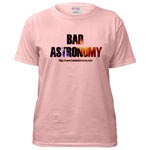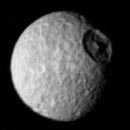
| Bad Astronomy |
|
|
|
BA Blog
|
|
Q & BA
|
|
Bulletin Board
|
| Media |
|
|
|
Bitesize Astronomy
|
|
Bad Astro Store
|
|
Mad Science
|
|
Fun Stuff
|
| Site Info |
|
|
|
Links
|
| RELATED SITES |
| - Universe Today |
| - APOD |
| - The Nine Planets |
| - Mystery Investigators |
| - Slacker Astronomy |
| - Skepticality |
Buy My Stuff

Keep Bad Astronomy close to your heart, and help make me
filthy rich. Hey, it's either this or one of those really
irritating PayPal donation buttons here.
Saturn's Moon Mimas and the Death Star
Week of March 17, 1997Last week's snack talked about how Mimas, a moon of Saturn, gravitationally "sweeps out" a gap in Saturn's rings. You might think that would be Mimas' major claim to fame in the solar system. You'd be wrong...
Nobody knew much about the moons of Saturn until the Voyager probes went there in 1980. There were so many surprises returned that it's hard to pick out any one that was the most surprising, but I bet the closeup of Mimas ranks in the top ten.
 This picture is not from "Star Wars"! It is from
from Voyager 1 and shows a whopping big impact crater
dominating the profile of the moon. Note that Mimas is about
400 kilometers across (about 250 miles). The crater, named Herschel,
is 130 kilometers across. The wall around the crater is
5 kilometers high, and that central peak rises 6 kilometers
above the surface (many impact craters have a large central peak which
is caused by a pressure rebound from the impact). This is the largest
crater in the solar system when compared to the size of the parent body.
If the monster asteroid that hit Mimas had been any bigger or moving
any faster, the whole moon may have shattered! As it is, there are enormous
cracks on the opposite side of Mimas from the crater where the pressure waves
from the impact converged and were amplified, wreaking havoc on the surface.
The backside is also covered with craters to the point of saturation. Any more
impacts will actually eradicate more craters than they create.
This picture is not from "Star Wars"! It is from
from Voyager 1 and shows a whopping big impact crater
dominating the profile of the moon. Note that Mimas is about
400 kilometers across (about 250 miles). The crater, named Herschel,
is 130 kilometers across. The wall around the crater is
5 kilometers high, and that central peak rises 6 kilometers
above the surface (many impact craters have a large central peak which
is caused by a pressure rebound from the impact). This is the largest
crater in the solar system when compared to the size of the parent body.
If the monster asteroid that hit Mimas had been any bigger or moving
any faster, the whole moon may have shattered! As it is, there are enormous
cracks on the opposite side of Mimas from the crater where the pressure waves
from the impact converged and were amplified, wreaking havoc on the surface.
The backside is also covered with craters to the point of saturation. Any more
impacts will actually eradicate more craters than they create.
To have a crater of this proportion on the Earth, it would have to be over 4000 kilometers across. That's about the length of the United States!
Note added March 29, 1999:
Loyal Reader Pete Maynard pointed out to me that the crater
Stickney on Mars' moon Phobos is also a whopper, and is roughly the
same size in proportion to Phobos as Herschel is to Mimas. I cannot seem to
find good numbers for the size of Stickney, but my rough estimate
from pictures indicates Pete is right. So Mimas and Phobos are in a dead
heat, within error, for largest crater relative to the parent.
If you are curious, you can check out Bill Arnett's
Nine Planets site for images of Phobos as well.
Wanna know more about Mimas?
If you are ever looking for info on anything in the solar system, you should always start at Bill Arnett's Nine Planets site. That's where I got the numbers for this page.
|
|
| THE PANTRY: ARCHIVE OF BITESIZE SNACKS |
|
|
| Subscribe to the Bad Astronomy Newsletter! |
| Talk about Bad Astronomy on the BA Bulletin Board! |